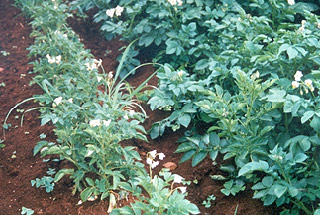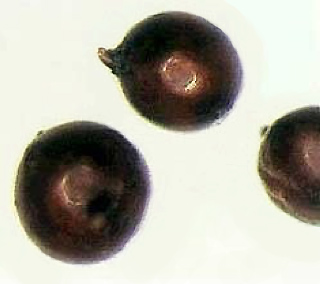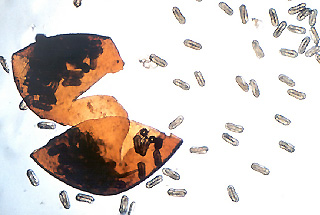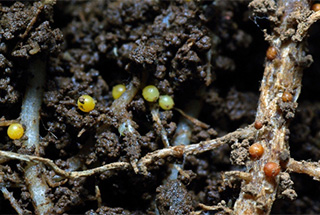Potato cyst nematode
Notice
Potato cyst nematode (Globodera rostochiensis) is a declared notifiable pest under Section 17 of the Plant Biosecurity Act 2010.
If you know or have reason to suspect that potato cyst nematode (PCN) is present on any property in Victoria, you must notify Agriculture Victoria by calling 136 186 or emailing Market.Access@agriculture.vic.gov.au.
Notifications must be made within 7 days of becoming aware or suspecting the presence of PCN.
About potato cyst nematode
G. rostochiensis or potato cyst nematode are microscopic, worm-like organisms that are less than 1 mm in length. PCN primarily feed on the roots of potatoes, tomatoes, and other plants of the Solanaceae family.
They are one of the most serious threats to potato production worldwide and can cause devastating yield loss in susceptible crops. Damage associated with the presence of a PCN infestation varies from small patches of stunted plants, commonly referred to as a 'lens' (Figure 1), to complete crop failure.

PCN reproduce sexually and their life cycle is characterised by six stages: egg, four juvenile stages, and adult.
Eggs are contained within a cyst (Figure 2), which are the expanded dead bodies of female nematodes. After the eggs hatch, the juveniles leave the cyst and invade the roots of susceptible host plants. After reaching maturity, 200 to 500 eggs develop within mated females, which in turn form new cysts as the female dies (Figure 3).
Cysts that contain viable eggs remain dormant in the soil until the next potato (or other Solanaceous host) crop is planted. Dormant cysts are reported to survive in soil for up to 20 years.


At present, golden potato cyst nematode (G. rostochiensis) has been detected in parts of Victoria, but pale potato cyst nematode (Globodera pallida) is not yet known to occur in Australia and would require an emergency plant pest response if detected.
G. rostochiensis was previously detected in Western Australia but has since been eradicated from the state.
The following symptoms can indicate the presence of PCN:
- stunted growth
- dieback, death, and senescence of plants which generally starts at the tips and progresses inward toward the stem
- chlorosis (yellowing) of leaves
- a reduced root system that is abnormally branched and brown in colour
- decreased tuber size (but not quality or quantity)
- presence of cysts (approximately 0.5mm diameter) on the surface of potato roots at the time of flowering (Figure 4).

PCN primarily spread via the transfer of infested soil that is adhered to plants and other objects.
This includes:
- potatoes
- agricultural equipment and bins used in the cultivation of potatoes
- bulbs and some nursery stock
To minimise the risk of introducing PCN to your property, ensure all machinery, equipment, and bins arrive on your property cleaned free of visible soil. Planting PCN tested and certified seed potatoes will also reduce the risk of PCN being introduced.
To prevent the increase of PCN populations on your property, ensure resistant crops are planted and other management methods such as longer crop rotations, chemical control, and effective surveillance are utilised.
In Victoria, PCN is known to occur in the following districts:
- Boneo
- Wandin
- Gembrook
- Koo Wee Rup
- Thorpdale.
Legislation is enacted under the Plant Biosecurity Act 2010 declaring all PCN-affected parcels of land in these districts to be Control Areas for the purpose of preventing the spread of PCN.
All owners/operators of PCN-affected land require a permit to move PCN hosts from their land. If you require a permit, please contact Plant Standards on 136 186 or plant.standards@agriculture.vic.gov.au.
The role of government and industry in PCN management in Victoria is also outlined in the PCN Management Policy for Victoria.
Effective 1 September 2021, all owners and operators of land within the PCN Control Area are required to apply for a permit to remove PCN host material from their land.
PCN host material includes the following:
- all PCN host plants and their products, including:
- any plant or plant product of the Solanaceae family (excluding above-ground fruit); and
- any root vegetables, and
- any bulb, and
- any seedling, and
- any nursery plant or tree.
- any earth material, meaning soil, gravel, sand or rocks; and
- any packages or bulk containers, including anything in or by which host plants or plant products are contained, wrapped or packed; and
- any used equipment, including any vehicle associated with the cultivation, harvesting, handling, transport or processing of PCN host plants or plant products.
For further information on how this change might apply to you, see FAQs – potato cyst nematode control area and related permits.
To apply for a permit, please visit the plant biosecurity permit page to download an application form. Completed forms can be submitted to Plant.Standards@agriculture.vic.gov.au.
Alternatively, contact 136 186 to have one mailed to you, and follow the submission instructions on the application form.
Interstate trade regulations exist to prevent the spread of PCN into other states and territories. Contact the relevant state authority for more information regarding interstate requirements for PCN hosts.
Download:
Reporting an unusual plant insect pest or disease
Report any unusual plant pest or disease immediately using our online reporting form or by calling the Exotic Plant Pest Hotline on 1800 084 881. Early reporting increases the chance of effective control and eradication.
Please take multiple good quality photos of the pests or damage to include in your report where possible, as this is essential for rapid pest and disease diagnosis and response.
Your report will be responded to by an experienced staff member, who may seek more information about the detection and explain next steps.
Report online